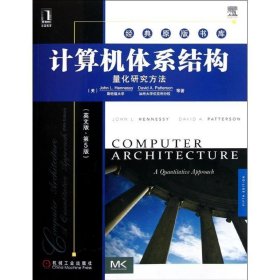
计算机体系结构 量化研究方法
¥ 31 2.2折 ¥ 138 九五品
仅1件
作者亨尼西 (John L.Hennessy), David A
出版社机械工业出版社
ISBN9787111364580
出版时间2012-01
版次1
装帧平装
开本16开
纸张胶版纸
页数493页
定价138元
上书时间2024-05-16
- 最新上架
商品详情
- 品相描述:九五品
- 商品描述
-
基本信息
书名:计算机体系结构 量化研究方法
定价:138元
作者:亨尼西 (John L.Hennessy), David A.Patterson, 等
出版社:机械工业出版社
出版日期:2012-01-01
ISBN:9787111364580
字数:
页码:493
版次:1
装帧:平装
开本:16开
商品重量:
编辑推荐
《计算机体系结构:量化研究方法(英文版•第5版)》特色:更新相关内容以覆盖移动计算变革,并强调当今体系结构中最重要的两个主题:存储器层次结构和各种并行技术。每章中的“Putting It All Together”小节关注了业界的各种 ,包括ARM Cortex-A8、Intel Core i7、NVIDIAGTX-280和GTX-480 GPU,以及一种Google仓库级计算机。每章都设计了常规主题:能力、性能、成本、可依赖性、保护、编程模型和新趋势。书中包括3个附录,另外8个附录可以在原出版社网站在线得到。每章最后都设置了由工业界和学术界专家提供的经过更新的案例研究,以及与之配套的全新练习题。
内容提要
《计算机体系结构:量化研究方法(英文版•第5版)》堪称计算机系统结构学科的“”,是计算机设计领域学生和实践者的经典。《计算机体系结构:量化研究方法(英文版•第5版)》系统地介绍了计算机系统的设计基础、存储器层次结构设计、指令级并行及其开发、数据级并行、gpu体系结构、线程级并行和仓库级计算机等。现今计算机界处于变革之中:移动客户端和云计算正在成为驱动程序设计和硬件创新的主流范型。因此在这个版中,作者考虑到这个巨大的变化,重点关注了新的平台(个人移动设备和仓库级计算机)和新的体系结构(多核和gpu),不仅介绍了移动计算和云计算等新内容,还讨论了成本、性能、功耗、可靠性等设计要素。每章都有两个真实例子,一个来源于手机,另一个来源于数据中心,以反映计算机界正在发生的革命性变革。《计算机体系结构:量化研究方法(英文版•第5版)》内容丰富,既介绍了当今计算机体系结构的研究成果,也引述了许多计算机系统设计开发方面的实践经验。另外,各章结尾还附有大量的习题和参考文献。《计算机体系结构:量化研究方法(英文版•第5版)》既可以作为高等院校计算机专业高年级本科生和研究生学习“计算机体系结构”课程的教材或参考书,也可供与计算机相关的专业人士学习参考。海报:
目录
ForewordPrefaceAcknowledgmentsChapter 1 Fundamentals of Quantitative Design and Analysis1.1 Introduction1.2 Classes of Computers1.3 Defining Computer Architecture1.4 Trends in Technology1.5 Trends in Power and Energy in Integrated Circuits1.6 Trends in Cost1.7 Dependability1.8 Measuring, Reporting, and Summarizing Performance1.9 Quantitative Principles of Computer Design1.10 Putting It All Together: Performance, Price, and Power1.11 Fallacies and Pitfalls1.12 Concluding Remarks1.13 Historical Perspectives and References Case Studies and Exercises by Diana FranklinChapter 2 Memory Hierarchy Design2.1 Introduction2.2 Ten Advanced Optimizations of Cache Performance2.3 Memory Technology and Optimizations2.4 Protection: Virtual Memory and Virtual Machines2.5 Crosscutting Issues: The Design of Memory Hierarchies2.6 Putting It All Together: Memory Hierachies in the ARM Cortex-AS and Intel Core i72.7 Fallacies and Pitfalls2.8 Concluding Remarks: Looking Ahead2.9 Historical Perspective and References Case Studies and Exercises by Norman P. Jouppi, Naveen Muralimanohar, and Sheng LiChapter 3 nstruction-Level Parallelism and Its Exploitation3.1 Instruction-Level Parallelism: Concepts and Challenges3.2 Basic Compiler Techniques for Exposing ILP3.3 Reducing Branch Costs with Advanced Branch Prediction3.4 Overcoming Data Hazards with Dynamic Scheduling3.5 Dynamic Scheduling: Examples and the Algorithm3.6 Hardware-Based Speculation3.7 Exploiting ILP Using Multiple Issue and Static Scheduling3.8 Exploiting ILP Using Dynamic Scheduling, Multiple Issue, and Speculation3.9 Advanced Techniques for Instruction Delivery and Speculation3.10 Studies of the Limitations oflLP3.11 Cross-Cutting Issues: ILP Approaches and the Memory System3.12 Multithreading: Exploiting Thread-Level Parallelism to Improve Uniprocessor Throughput3.13 Putting It All Together: The Intel Core i7 and ARM Cortex-AS3.14 Fallacies and Pitfalls3.15 Concluding Remarks: What's Ahead?3.16 Historical Perspective and References Case Studies and Exercises by Jason D. Bakos and Robert R ColwellChapter4 Data-Level Parallelism in Vector, SIMD, and GPU Architectures4.1 Introduction4.2 Vector Architecture4.3 SIMD Instruction Set Extensions for Multimedia4.4 Graphics Processing Units4.5 Detecting and Enhancing Loop-Level Parallelism4.6 Crosscutting Issues4.7 Putting It All Together: Mobile versus Server GPUS and Tesla versus Core i74.8 Fallacies and Pitfalls4.9 Concluding Remarks4.10 Historical Perspective and References Case Study and Exercises by Jason D. BakosChapter 5 Thread-Level Parallelism5.1 Introduction5.2 Centralized Shared-Memory Architectures5.3 Performance of Symmetric Shared-Memory Multiprocessors……Chapter6 Warehouse-Scale Computers to Exploit Request-Level and Data-Level ParallelismAppendix A Instruction Set PrinciplesAppendix B Review of Memory HierarchyAppendix C Pipelining: Basic and Intermediate Concepts
作者介绍
John L.Hennessy,斯坦福大学校长,IEEE和ACM会士,美国国家工程研究院院士及美国科学艺术研究院院士。Hennessy教授因为在RISC技术方面做出了突出贡献而荣获2001年的Eckert-Mauchly奖章,他也是2001年Seymour Cray计算机工程奖得主,并且和本书另外一位作者David A. Patterson分享了2000年John von Neumann奖。David A. Patterson 加州大学伯克利分校计算机科学系主任、教授,美国国家工程研究院院士,IEEE和ACM会士,曾因成功的启发式教育方法被IEEE授予James H. Mulligan,Jr.教育奖章。他因为对RISC技术的贡献而荣获1995年IEEE技术成就奖,而在RAID技术方面的成就为他赢得了1999年IEEE Reynold Johnson4R息存储奖。2000年他John L. Hennessy分享了John yon Neumann奖。
序言
-

【封面】
相关推荐
-

计算机体系结构量化研究方法。
九品南昌
¥ 31.00
-

计算机体系结构:量化研究方法
九五品北京
¥ 91.00
-

计算机体系结构:量化研究方法
九五品北京
¥ 42.00
-

计算机体系结构:量化研究方法
九五品南京
¥ 24.00
-

Computerarchitecture计算机体系结构量化研究方法
全新保定
¥ 164.09
-

Computerarchitecture计算机体系结构量化研究方法
全新保定
¥ 173.55
-

Computerarchitecture计算机体系结构量化研究方法
全新北京
¥ 200.46
-

Computerarchitecture计算机体系结构量化研究方法
全新廊坊
¥ 189.30
-

计算机体系结构
八五品枣庄
¥ 0.01
-

计算机体系结构
八五品济南
¥ 4.30
— 没有更多了 —












以下为对购买帮助不大的评价